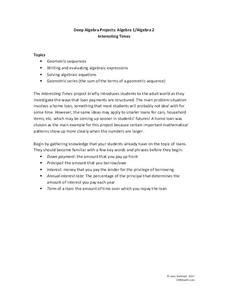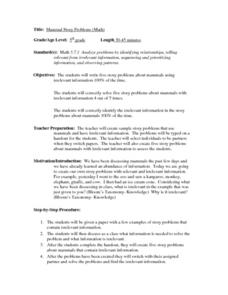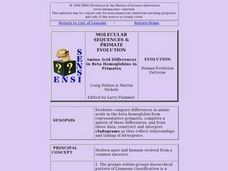Curated OER
Multiplicative Sequences
Students investigate the concepts related to the practice of multiplication facts. They look for number patterns in order to create an algorithm in order to find the correct sequencing of number patterning. The solutions are then...
Curated OER
Exploring Number Patterns
Seventh graders recognize number patterns. As a class, 7th graders discuss strategies for solving number patterns. Given a pattern, they determine the missing terms. They complete a pattern worksheet.
Curated OER
Number Sequencing
In this number sequencing activity, 6th graders solve 5 different sets of numbers that include various types of sequences. They write the missing numbers in each set on the baseballs shown. Students add or subtract numbers when necessary...
Curated OER
Letter Patterns
Second graders look at the number patterns we get from letters and numbers. They keep track of the numbers involved by drawing up a table of values. It's important here to look for the pattern and see how the number of tiles changes from...
Curated OER
Counting Sequences
In this counting sequence instructional activity, students fill in missing numbers in a series of 8 number patterns. Patterns appear in sets of boxes in rows.
Curated OER
Domain & Range of Functions
In this function worksheet, students determine the domain and range of given functions. They identify terms in a sequence of integers, This two-page worksheet contains seven multi-step problems.
Curated OER
I Have A Friend Who
In this friend instructional activity, students use logic and reasoning to determine the characteristics of a person. This one-page instructional activity contains 1 problem. The answer is provided.
Noyce Foundation
Tri-Triangles
Develop an understanding of algebraic sequences through an exploration of patterns. Five leveled problems target grade levels from elementary through high school. Each problem asks young mathematicians to recognize a geometric pattern....
Howard Hughes Medical Institute
Ebola: Disease Detectives
How did the Ebola virus first infect humans? Young virologists examine genetic sequences from the 2014 Sierra Leone outbreak to find similarities during a riveting activity. Following similar methods used by MIT and Harvard, partners...
West Contra Costa Unified School District
Arithmetic Series
Fall for a series. Learners determine how to find out how far a skydiver falls in the first 20 seconds. The Algebra II lesson introduces the idea of adding up the terms of an arithmetic sequence. Pupils learn how to use Sigma notation to...
5280 Math
Interesting Times
Gain a little interest in functions with a real-life task. Young scholars analyze home loan data with a geometric sequence and series. They use the models to make predictions about the total loan payments at certain intervals in a...
Resources for Early Childhood
Making Math Meaningful and Enjoyable
Your young learners will enjoy mathematics that is meaningful correspondence as they play their way to a deep mathematical foundation. Organized around the math standards, this appropriate sequence of conceptual, preschool...
EngageNY
Analyzing Residuals (Part 1)
Just how far off is the least squares line? Using a graphing calculator, individuals or pairs create residual plots in order to determine how well a best fit line models data. Three examples walk through the calculator procedure of...
EngageNY
Algebraic Expressions—The Distributive Property
Do your classes truly understand the distributive property? Use a demonstrative lesson to represent the distributive property in various ways. Learners solidify understanding by creating a geometric pattern for distributive...
EngageNY
Analyzing a Data Set
Through discussions and journaling, classmates determine methods to associate types of functions with data presented in a table. Small groups then work with examples and exercises to refine their methods and find functions that work...
Curated OER
Sequences
For this trigonometry worksheet, students write formulas for sequences using a given pattern. There are 12 questions with an answer key.
Curated OER
Sequence of Events Practice 3-Rock Layers
In this rock layer worksheet, students are given a diagram showing a pattern of rock layers from oldest to youngest. Students list the sequence of events that occurred in order to form the pattern shown.
Curated OER
Take Home Question - Chapter 2
In this sequences worksheet, high schoolers solve 4 short answer problems. Students use clues to find the first, second, fourth, fifth, and nth terms in a sequence given only the third term.
Curated OER
Geometric Sequences and Series
In this algebra activity, students solve sequences using the geometric mean for sequences and series. They have to find the next number in the pattern using the formula for geometric means. There are 23 problems to be solved.
Curated OER
Mammal Story Problems (Math)
Fifth graders, after discussing the teacher's handout examples, practice writing five story problems about mammals using relevant/irrelevant information. As a class, they solve the story problems while identifying the key concepts that...
Curated OER
Molecular Sequences & Primate Evolution: Amino Acids, Hemoglobins in Evolution
Students compare differences in amino acids in the beta hemoglobin from representative primates, complete a matrix of those differences, and from these data, construct and interpret cladograms as they reflect relationships and timing of...
Curated OER
Infinite Geometric Series
For this geometric series worksheet, students examine a given geometric series to determine if the series converges or divergeas. They evaluate and determine the common ratio of a geometric series. This four-page...
Curated OER
A STEP IN SPECIATION
Students place different subspecies of a CA salamander are placed on grid map of CA according to where samples were collected. Then discuss patterns of their distribution, their likely evolutionary relationships, and probable sequence of...
Curated OER
Math 16C: Worksheet 11
In this calculus instructional activity, students answer 13 short-answer problems regarding number sequences, limits, convergence, divergence, polynomials and functions.























